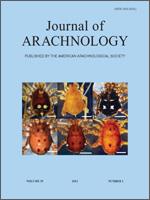We used data from 33 species of cursorial spiders in northern Mississippi (USA) to investigate the relative contributions of ecology and phylogeny to the reproductive trade-off between number and size of offspring. Sixty percent of the variation among genera for female reproductive allocation was due to differences between the family Pisauridae and the family Lycosidae. Temporal variation in reproductive allocation during the reproductive season was not observed for the majority of species examined. We found significantly different patterns of reproductive allocation among species within genera, suggesting that each species has responded to distinct selection pressures. Preliminarily, this extensive variation appears to be due mostly to interspecific competition and predation risk from other spiders. However, the patterns of reproductive allocation of species within a single guild (i.e., a group of species potentially competing for the same resources) for the two families are very different. Larger species of wolf spiders (family Lycosidae) within a given guild produce smaller numbers of larger offspring relative to the size of the mother, and smaller species produce the reverse. However, in nursery-web spiders (family Pisauridae) the larger species within a guild produce larger numbers of smaller offspring than expected. The current study provides an example of the flexibility of life history evolution despite phylogenetic constraints. It also demonstrates the potential for varying life history strategies to mediate competition, allowing similar species to coexist.
How to translate text using browser tools
1 April 2011
Determinants of differential reproductive allocation in wolf and nursery-web spiders
Amy C. Nicholas,
Gail E. Stratton,
David H. Reed
ACCESS THE FULL ARTICLE

The Journal of Arachnology
Vol. 39 • No. 1
April 2011
Vol. 39 • No. 1
April 2011
fecundity
interspecific competition
life-history evolution
Lycosoidea
Pisauridae
predatory dominance
trade-offs




